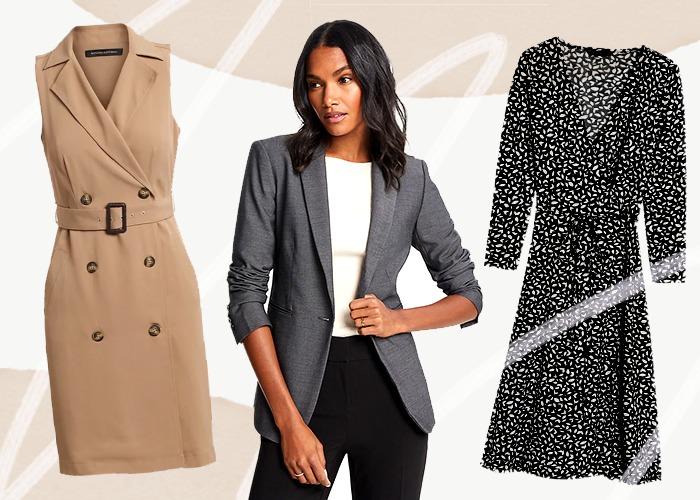8 Rules That Maximize My $50 Monthly Clothing Budget

The year after I had my second son was an interesting mix of relaxation and chaos. I liked that there were no obligations to go anywhere or wear anything specific. When that year was coming to an end, I began preparing — mentally and physically — to return to work. I was ecstatic to get paid to talk to adults and solve adult problems again (I still call it “Mommy Daycare”). And being away from my children gave me a new appreciation for the money I earned, so I had to make it count.
But I couldn’t wear sweatpants and hoodies to work, and I couldn’t wear anything from before I was pregnant — I was not the same size anymore. I had to start from scratch. So I made a plan that started out of necessity and grew into the guidelines I use to purchase clothes even now, five years later. I wanted to invest in high-quality clothing, but I couldn’t afford the price tag if I wanted to build a full wardrobe. The following guidelines helped me maximize my clothing budget, which is about $150 every three months. These tips should come in handy whether you need a whole new wardrobe like I did, or your wardrobe just needs a little refresh.
1. Categorize your clothing and make note of gaps.
I am a visual person and enjoyed taking every item of clothing out of my closet and drawers. I could have done this in my head or on a piece of paper, but there’s something satisfying about seeing everything laid out.
I identified categories for each part of my life that required a different type of clothing. My categories were work, casual, special occasions, and summer. (If your work and casual clothing are the same, that’s one less category to worry about.) Then, go through each item and decide whether you love it or you’re ready to replace it. This may mean trying it on to remember how you feel about the fabric, the length, the stain on the arm you can’t get out, and so on. Place each item that you love back into your closet and group into the appropriate category. This way, you can visually see your favorite clothes and make note of any gaps you see in a particular category.
Remember, you’ll probably need seven outfits to get through a full week because if you’re a working mom like me, you won’t have time to do laundry more frequently than that. Once you have all of the items you want to replace, make a list, which you’ll use when it’s time to go shopping.
2. Pick three coordinating colors.
When picking out items to buy, I suggest limiting yourself to three colors. This will make shopping and putting together outfits so much easier. My colors were black, white, and grey — risky, I know. But I preferred cool colors over earth tones, and I needed to make as many outfits as I could. Having to create a whole new wardrobe, my choices were limited. Any white shirt I had would easily match with grey or black pants, and vice versa.
Everything I bought, even patterns, had to be one of these three colors. If you prefer earth tones, start with beige, white, and green. If you prefer bold colors, you might select white and then add a bold color of choice in two different shades. Basically, you want to stay away from colors that are harder to find and won’t coordinate — otherwise, you’ll have to invest in more pieces to get the same number of outfits. This was the most important guideline for me. It helped narrow my choices, made me more intentional about what I purchased, and allowed me to maximize the “cost per wear” of items I purchased.
3. Research materials from high-end brands.
I worked in a business environment and I wanted quality suit pieces that did not make me sweat or stink and fit me well. I researched high-end brands for men’s suits online based on the brands that my husband wears like Calvin Klein, Ralph Lauren and found that wool is what these designers used; then, I researched stores in my closest mall directory that also used wool to make their suits. I found that Banana Republic made suit pieces that were 97% wool, and they were the same price as alternative polyester suits. I also found that Banana Republic had other pieces that were 99% cotton. I thought that would be great for the summer.
4. Try before you buy to ensure fit.
I do not enjoy clothing shopping in a store, especially with two tiny humans in tow. My boys would much rather hide under the clothing racks and run around the store, knocking clothes off racks, than watch their mom try on clothing.
Online shopping would be more convenient, but I was not confident that the clothes I selected would fit. So I found the closest Banana Republic and tried on different styles and sizes of clothing. This makes it easier to make decisions when you’re buying items online — you know what specific sizes in that brand work best for you.
Although you may choose to purchase from the outlet store, the main store will work for this step. I found that tank tops and sleeveless tops did not work for me, but the sweaters and the suit pieces fit me perfectly. Also, if you are a shorty like I am, try and look for a store that offers petite sizes so you don’t have to pay extra for hemming long pants. Take note of the style of pants, boot-cut, straight leg of the name of the style. This allowed me to be confident that I would select the correct size online.
5. Start shopping.
At this point, you should have all the tools you need to shop effectively and with intention. You have a list of items you need, core colors, materials to look for, and a store or two where you can focus your search.
I recommend starting with outlet stores, where many items are deeply discounted. With outlet shopping, I had a budget of $25 per item, including suit pieces, but I usually spent less. I signed up for emails so I got notified of sales and tried to plan my shopping around them. I would find items online that fit the guidelines of what needed and that were in my core colors, then add them all to my basket.
Finally, I would go through my basket and pick out the items that would maximize my budget and get me the most number of outfits. I didn’t buy items purely because they were on sale. Putting back those $15 pants that aren’t quite your style will save you $15. After all, it’s not a deal if you don’t wear it.
6. Add an accent color.
Once I had a foundation of clothing in my core colors, I felt more confident about adding color to my wardrobe. I needed a little variation and decided to add navy blue. I know, I know — I ventured far out with that one! But I knew navy blue would go with everything in my wardrobe and it was easy to find clothing in that color. Recently, I’ve been searching for light blue clothing to add to my wardrobe. It’s a bright color, but it will still match most everything I have. My general rule of thumb: an item has to go with at least 3-4 other things in my wardrobe, or I don’t buy it. When I need to replace pieces that are wearing out, I return to my initial core colors.
7. Conduct a seasonal closet audit.
Every season, I go through my closet and pull out everything I haven’t worn in the past three to six months. If any of these items can be worn as pajamas (think oversized sweaters, T-shirts, and comfy pants), I put them away in the PJ drawer.
If you find yourself struggling to let go of pieces even though you never wear them, I have a trick. Take anything you haven’t worn during the previous season and, instead of giving it away, give it another three to six months. Store it where outside of your closet, like under the bed or in a storage closet — anywhere you will not see it every day and feel like you need to put it back. Only take out an item out of this special hiding spot if you actually wear it, then you’re allowed to put it back into your closet.
After another three to six months, whatever is left in the bag you can give away without guilt, knowing that you truly did not miss it. I give anything that’s still in good shape to my nieces, and there are also great options for reselling your clothes, like ThredUp, Poshmark, or just your local consignment store. You can use this trick for other items, too. I used to declutter the whole house and put things in the spare bedroom for three to six months, and if my husband never asked, “where’s the ______?” it got donated. He still wonders what I got rid of, but for the life of him, he can’t think of anything that is missing, and I am not reminding him.
8. Maintain your clothes.
I still do not budget a considerable amount for clothing. I have other spending priorities, so I need to maintain my clothes to protect my investment. I try them on and notice any repairs or alterations that need to be made, like if the hem on my pants needs to be resewn. I cold-water wash all my clothes in the machine on the delicate cycle and hang them to dry. To save money and time, I avoid buying dry-clean-only clothes.
If you think of your clothing as disposable, then the money you’re spending is about as valuable as a lottery ticket. You’re happy with your purchase at the moment and hope it will bring more happiness in the future. But when you don’t win, you have nothing to show for the money you spent. Maintaining your clothes requires time and effort, but it can save you money in the long run.
*****
My body will never be the same as the body I had before having children, and I definitely don’t have the time or money to waste on clothing I won’t wear. Thus, I had to be very mindful of how to rebuild my wardrobe from scratch. The above guidelines gave me more confidence in my purchases. They also saved me time searching for clothing that I won’t wear — and any extra time I have to spend with my tiny humans is so worthwhile.
Charlene Henderson is married and lives in Calgary, Alberta. She is the mom of two crazy boys: Tidus, 7, and Tycho, 5. She works full-time in the public sector.
Like this story? Follow The Financial Diet on Facebook, Instagram, and Twitter for daily tips and inspiration, and sign up for our email newsletter here.




